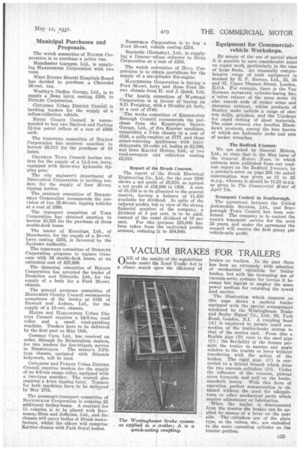VACUUM BRAKES FOR TRAILERS
Page 87

If you've noticed an error in this article please click here to report it so we can fix it.
/INF! of the retralts of the regulations
Li made under Road Traffic Act is a closer .watch upon the efficiency of
brakes on trailers. In the past there has been an extremely wide adoption of mechanical operation for trailer brakes, but with the increasing use of vacuum-servo systems for lorries it becomes but logical to employ the same power medium for retarding the towed load carrier.
The illustration which appears on :this page shows a modern trailer equipped with the special arrangement marketed by the Westinghouse Brake and Saxby Signal Co., Ltd., 82, York Road, London, N.1. A coupling head (A) is employed to perthit rapid connection of the trailer-brake system to that of the motive unit. From this a flexible pipe (B) runs to the steel pipe (0) ; the flexibility of the former permits the trailer to assume any angle relative to the tractdr or lorry without interfering with the action of the brakes. The rigid pipe (C) is connected to a lateral branch which joins the two vacuum cylinders (D). Under the influence of the vacuum, pistons move forwards and pull on the brakecamshaft levers. With this form of operation perfect compensation is obtained without the need for whippletrees or other mechanical parts which require adjustment or lubrication.
When the trailer is disconnected from the tractor the brakes can be applied by aneans of a lever on the near side. The cylinders are of the plain type, as the valves, etc., are embodied in the main• operating cylinder on the tractor portion.




































































































































































































